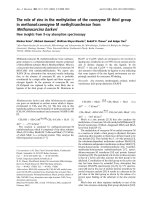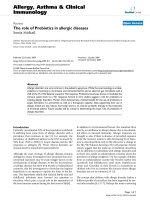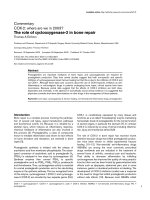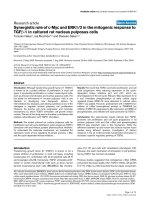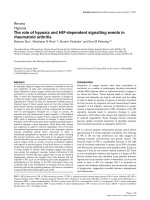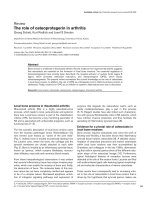Báo cáo y học: "Regulatory role of E-NTPase/E-NTPDase in Ca2+/Mg2+ transport via gated channel" doc
Bạn đang xem bản rút gọn của tài liệu. Xem và tải ngay bản đầy đủ của tài liệu tại đây (811.64 KB, 12 trang )
BioMed Central
Page 1 of 12
(page number not for citation purposes)
Theoretical Biology and Medical
Modelling
Open Access
Research
Regulatory role of E-NTPase/E-NTPDase in Ca
2+
/Mg
2+
transport via
gated channel
Hans M Schreiber
1
and Subburaj Kannan*
1,2
Address:
1
Division of Gastroenterology, School of Medicine, University of Pennsylvania, Philadelphia, PA 19104, USA and
2
Departments of
Microbiology and Immunology, School of Medicine, PO Box 25056, University of Texas Medical Branch, 300 University Boulevard, Galveston,
Texas, 77550 USA
Email: Hans M Schreiber - ; Subburaj Kannan* -
* Corresponding author
Abstract
Background: E-NTPase/E-NTPDase is activated by millimolar concentrations of Ca
2+
or Mg
2+
with a pH optimum of 7.5 for the hydrolysis of extracellular NTP and NDP. It has been generally
accepted that E-NTPase/E-NTPDase plays regulatory role in purinergic signalling, but other
functions may yet be discovered.
Results: In this article it is proposed on the basis of published data that E-NTPase/E-NTPDase
could play a role in the influx and efflux of Ca
2+
and Mg
2+
in vivo.
Conclusions: Attenuation of extracellular Ca2+ influx by rat cardiac sarcoplasmic anti-E-NTPase
antibodies and oligomerization studies on mammalian CD39 conclusively point towards the
existence of a new channel in the membrane. Further studies on these properties of the E-NTPase/
E-NTPDase may provide detailed mechanisms and identify the potential patho-physiological
significance.
Background
The mechanism by which [Ca
2+
]
i
is increased in excitable
cells differs from that obtaining in non-excitable cells.
Excitable cells exhibit an action potential, a substantial
general depolarization of the plasma membrane, in
response to depolarizing stimuli; influx of Ca
2+
occurs via
plasma membrane Ca
2+
channels and/or release from
sarco (endo) plasmic reticulum via ryanodine-receptor
Ca
2+
channels which regulate the excitation – contraction
coupling [1,2]. The factors that determine the extent of
Ca
2+
entry are (i) magnitude of the membrane potential
and (ii) magnitude of the transmembrane Ca
2+
gradient.
These two factors also determine whether Ca
2+
or Mg
2+
enters and the time (probably milliseconds) that elapses
between channel opening and termination of Ca
2+
or
Mg
2+
transport [3].
In non-excitable cells, the increase in [Ca
2+
]
i
results from
influx of Ca
2+
across the plasma membrane and Ca
2+
release from the endoplasmic reticulum. Ca
2+
release from
the SER depends on the binding of inositol 1,4,5-triphos-
phate (InsP
3
) to its receptor Ca
2+
channels, and also on
Ca
2+
binding to ryanodine receptor – Ca
2+
channels.
Ca
2+
is removed from the cell by the following means. i:
the sarco (endo) plasmic reticular Ca
2+
pump ATPase
(SERCA), which transports Ca
2+
from the cytoplasm into
the SER lumen (~70% of the activator Ca
2+
); ii: The
plasma membrane Ca
2+
pump ATPase (PMCA), which
Published: 12 August 2004
Theoretical Biology and Medical Modelling 2004, 1:3 doi:10.1186/1742-4682-1-3
Received: 31 May 2004
Accepted: 12 August 2004
This article is available from: />© 2004 Schreiber and Kannan; licensee BioMed Central Ltd.
This is an open-access article distributed under the terms of the Creative Commons Attribution License ( />),
which permits unrestricted use, distribution, and reproduction in any medium, provided the original work is properly cited.
Theoretical Biology and Medical Modelling 2004, 1:3 />Page 2 of 12
(page number not for citation purposes)
exports Ca
2+
across the plasma membrane (~1% of the
activator Ca
2+
); iii: Mitochondrial Ca
2+
Uniporters (mCa
2+
uniporters), which transport Ca
2+
into mitochondria
(~1% of the activator Ca
2+
);iv: the Na
+
/Ca
2+
exchanger
(28% of the activator Ca
2+
). This last transport system is
reversible but under normal physiological conditions, in
the Ca
2+
extrusion mode, it exhibits a stoichiometry of 3
Na
+
influx/1 Ca
2+
efflux [4].
Ca
2+
enters animal cells via (i) voltage-operated Ca
2+
chan-
nels (VOCC), (ii) ligand gated non-specific cation chan-
nels (LGCCS), and (iii) stretch/receptor activated non-
specific Ca
2+
channels (RACC) [4,5]. A "receptor operated
Ca
2+
channel" (ROCC) is defined as a plasma membrane
Ca
2+
channel other than VOCC or RACC. VOCC opening
depends on membrane depolarization, whereas RACC
opening depends on both direct and indirect activation of
membrane bound receptors. In contrast, ROCC opening
depends solely on agonist-receptor interaction. It has also
been suggested that mobile intracellular messengers such
as elevated [Ca2+]i play a role in ROCC opening [5,6].
Different types of ROCC are activated (opened) by diverse
cell signaling mechanisms such as ligand specificity,
increase in [Ca
2+
]
I
, increase in [cAMP]
i
[7] and activation/
inactivation of specific trimeric G proteins [8].
Opening of Ca
2+
channels must be a highly regulated
event involving physical movement of channel compo-
nents inclusive of the alteration in channel protein con-
formation; Also, an extracellular source of free energy
(∆G) could be of critical importance. This might be sup-
plied by E-NTPase/E-NTPDase mediated hydrolysis of
NTP/NDP. Co-ordination of this process might play a role
in the opening of Ca
2+
channels, independently of mem-
brane depolarization or other factors.
The biochemical, structural, and functional properties of
E-type nucleotidases have been covered in several excel-
lent reviews: i. Extracellular metabolism [9]; ii. purine sig-
nalling [10,11]; iii. adhesion [12]; iv. transporter
functions [13]; v. pathophysiology [14,15].
Rationale for the proposed hypothesis: E-NTPase/E-
NTPDase mediated Ca
2+
/Mg
2+
transport
It has been suggested that Ca
2+
entry during the slow
inward current in normal myocardium involves mem-
brane-bound channels potentially controlled and/or reg-
ulated by metabolic energy transfer from unknown
sources, though Ca
2+
enters the cell down its concentra-
tion gradient [16]. Electrical stimulation and membrane
phosphorylation by cAMP-dependent protein kinase have
been shown to increase E-NTPase/E-NTPDase activity.
Metal ions such as Mn
2+
, Co
2+
, Ni
2+
and La
2+
that attenu-
ate Ca
2+
influx also inhibit the E-NTPase. In the late stages
of heart failure the E-NTPase is down regulated. Activation
of E-NTPase by various concentrations of Ca
2+
has been
shown to correlate linearly with cardiac contractile force
development [17].
"Calcium paradox" is defined as irreversible functional
and structural protein loss in the isolated heart that is first
perfused with Ca
2+
-free buffer and then reperfused with
Ca
2+
-containing buffer [18]. E-NTPase activity is highest
during the initial phases of reperfusion, which might
favour the initial Ca
2+
influx that causes Ca
2+
overload.
During the later stages of reperfusion with Ca
2+
-contain-
ing buffer there is a loss of E-NTPase activity. During mild
stages of Ca
2+
paradox, E-NTPase retains its function and
continues to favour Ca
2+
influx, resulting in the develop-
ment of intracellular Ca
2+
overloads. However, during
severe stages of calcium paradox, impaired E-NTPase
activity may contribute to irreversible failure of contractile
force recovery [19].
To date there is no report describing the detailed mecha-
nism of E-NTPase/E-NTPDase-mediated channel gating
and its role in Ca
2+
/Mg
2+
transport. In this article an
attempt is made to delineate the molecular mechanism of
Ca
2+
/Mg
2+
transport, identifying the source of energy and
the activation and termination of the process. The central
issues are:
a. How the metabolic energy from nucleotide hydrolysis
is effectively utilized in channel opening;
b. What stage of the opening/closing cycle requires
energy;
c. By what (probable) mechanism the proposed scheme is
completed;
d. How, if at all, homeostasis is affected
The current hypothetical proposal is set out in three sec-
tions with appropriate illustrations.
Phase I: Activation
identifies the evidence that leads to the current proposal
and describes how the metabolic energy from nucleotide
triphosphate hydrolysis is utilised to assemble a func-
tional homo-oligomer of the E-NTPase/E-NTPDase, form-
ing a channel that is subsequently opened.
Phase II: Suggested: Ca
2+
/Mg
2+
Transport
Describes, with supporting evidence, how the energy
released from [NTP] o/ [NDP] o hydrolysis might be uti-
lized for opening the channel formed by the homo-oligo-
meric ENTPase/E-NTPDase.
Theoretical Biology and Medical Modelling 2004, 1:3 />Page 3 of 12
(page number not for citation purposes)
Phase III: Termination of the transport processes
outlines the intracellular and extracellular factors that
would influence the termination of the Ca
2+
/Mg
2+
trans-
port processes, and the experimental evidence obtained in
favor of the whole proposal.
Phase I: Activation of E-NTPase/E-NTPDase and channel
formation
Membrane depolarization could locally alter protein con-
formation. This in turn could potentially induce post-
translational modification in the (intracellular) monomer
subunits of the E-NTPase/E-NTPDase, followed by trans-
location to the membrane (depending on the tissue
type(s) and functional requirement(s)) (Fig. 1). Fig. 2
shows the proposed functional state of the E-NTPase/E-
NTPDase after oligomerization and assembly in the mem-
brane to form a gated Ca
2+
/Mg
2+
channel. Fig. 3, indicates
that the oligomerized E-NTPase/E-NTPDase is likely to
possess sensors to control the opening and closing of the
Ca
2+
/Mg
2+
channel gate. Fig. 4, represents an interior view
of the E-NTPase/E-NTPDase in the functional state after
oligomerization and assembly in the membrane.
Probable energy sources and other significant factors are
as follows. The source of extracellular nucleotides could
be spontaneous release from dead cells or exocytosis from
live/damaged cells [20]. In ocular ciliary epithelial cells,
ATP is released in hypotonic conditions, and this release
Phase I: ActivationFigure 1
Phase I: Activation. Based on direct experimental evidence, suppose that in response to electrical stimuli, an increased
phosphatidylinositol turnover leads to elevated intracellular phospholipid. This in turn could induce post-translational modifica-
tion of the monomer subunits of E-NTPase/E-NTPDase in the intracellular milieu. Subsequently, the monomers are translo-
cated to the membrane, depending on the tissue type(s) and functional requirement(s).
Electrical Stimulation (see Fig 1;2;3-Mol.Cell.Biochem, 77;135-141(1987)
Increased Phosphatdylinositol
turnover
Increased Phospholipid turnover
E-NTPaseTranslocation
to membrane
Increased Olgomerization of E-NTPase monomer(s)
PHASE I: ACTIVATION
E-NTPase: ROLE AS A Ca
2+
/Mg
2+
TRANSPORTER
VIA CHANNEL GATING:
Theoretical Biology and Medical Modelling 2004, 1:3 />Page 4 of 12
(page number not for citation purposes)
is inhibited by NPPB (5-nitro-2-(3-phenyl propylamine
benzoic acid), a potent inhibitor of CFTR (cystic fibrosis
transmembrane receptor) and p-glycoprotein mediated
ATP release [21]. On the other hand, the endogenous
CD39 of oocytes transforms under hypertonic conditions
to a conformation mediating ATP transport to the extra-
cellular environment, either by exocytosis or by acting as
an ion channel [22,23]. However, under what conditions
(hyper-or hypotonic) might CD39 assume an extracellu-
lar nucleotide hydrolyzing activity; and under those con-
ditions, can this property be coupled to ion influx? This
question remains unanswered.
At normal physiological temperature in presence of diva-
lent succinyl CoA, Con A mediates the oligomerization of
E-NTPase monomers/dimers to form a holoenzyme with
enhanced activity. Eosin iodoacetamide (EIAA), a fluores-
cein iodoacetamide that forms thioester bonds with
cysteine at neutral pH, enhances chicken gizzard ecto-
ATPase activity [24].
There are ten conserved cysteine residues in E-NTPase
(with additional cysteine residues in the N-terminal
region that are known to mediate disulfide bond forma-
tion, essential in oligomerization). CD39, an ecto-Ca
2+
/
Mg
2+
apyrase that hydrolyses ATP and ADP [25], forms
tetramers and might act as a bivalent cation channel.
Phase I: ActivationFigure 2
Phase I: Activation. Proposed model for E-NTPase/E-NTPDase in a functional state after oligomerization and assembly in
the membrane, functioning as a gated channel.
Theoretical Biology and Medical Modelling 2004, 1:3 />Page 5 of 12
(page number not for citation purposes)
However, the precise mechanism and functional proper-
ties are not known at present. CD39 expression is
associated with ATP release; it was speculated that ATP
release (along with drugs) into the extracellular milieu is
followed by the hydrolysis of the extracellular nucleotides
by CD39 [26].
Furthermore, native CD39 (ecto-ATP/Dase/ apyrase)
forms tetramers upon oligomerization. Loss of either of
the two transmembrane domains of rat CD39 ecto-ATP/
Dase impairs enzyme activity. It has been suggested that
the functional (holoenzyme) E-NTPase/E-NTPDase is a
homotrimer in mammals.
Differences in enzyme activity among different species
have been attributed to variations in the interaction
among the monomers resulting in homotrimeric holoen-
zyme formation (66 kDa-ATPase) [27]. It seems clear that
changes in the conformation of the E-NTPase/E-NTPDase
could mediate changes in the channel transport function.
Phase II: Ca
2+
/Mg
2+
Transport
Fig. 5a, illustrates the possible utilization of the energy
released from [NTP] o /[NDP] o hydrolysis (-7.3 kcal mol
-
1
or by formation of AMP, -10.9 kcal/mol
-1
) for opening
the channel formed by the homo-oligomeric E-NTPase/E-
NTPDase. This channel is postulated to open and close in
Phase I: ActivationFigure 3
Phase I: Activation. The oligomerized E-NTPase/E-NTPDase would probably possess hypothetical sensors acting to open/
close the gates.
Sensor for opening
of the channel
Theoretical Biology and Medical Modelling 2004, 1:3 />Page 6 of 12
(page number not for citation purposes)
response to energy availability (Fig. 5b). Fig. 6A, is an art-
ist's impression of the three-dimensional configuration of
the E-NTPase/E-NTPDase in vivo. Ca
2+
might enter the cell
and excess Mg
2+
might leave by the influx and efflux
mechanisms depicted in Fig 6b.
The opening of the slow inward Ca
2+
current channel in
cardiac sarcolemma during the plateau phase of the action
potential requires ATP [28]. Furthermore, protein kinase-
A (PKA) dependent phosphorylation appears to mediate
the increase in Ca
2+
influx in hormonal modulation of
that process [29]. A similar model has been proposed for
sodium channels in nerve membranes, in which a cycle of
phosphorylation and dephosphorylation is proposed for
opening and closing [30].
Other corroborating evidence implicating E-NTPase in
Ca2+/Mg2+ transport via the gated channel is briefly sum-
marised. Rat cardiac sarcolemmal E-NTPase has consider-
able sequence homology with the human platelet
thrombospondin receptor CD36 [31]. An antibody
directed against the purified E-NTPase blocked the
increase in intracellular calcium concentration, implying
that the E-NTPase plays an unknown but significant role
in the delayed Ca
2+
influx or Mg
2+
efflux during the pla-
teau phase of the action potential (Unpublished observa-
tion). Activation of E-NTPase by millimolar
concentrations of Ca
2+
and electrical stimulation is
linearly related to the contractile force developed in the
myocardium [32]. Gramicidin S inhibits the E-NTPase
activity and it attenuates the slow channel efflux in per-
fused frog left ventricles.
Phase I: ActivationFigure 4
Phase I: Activation. Interior view of E-NTPase/E-NTPDase in a functional state in the membrane.
Theoretical Biology and Medical Modelling 2004, 1:3 />Page 7 of 12
(page number not for citation purposes)
Based on these observations, we propose that E-NTPase
might be involved in providing energy for Ca
2+
/Mg
2+
influx-efflux in the cardiac sarcolemma, opening the
channel formed by the E-NTPase/E-NTPDase protein by
altering the conformation of the sensors. The altered
channel sensor conformation opens the channel; loss of
the energy source allows the sensors to revert to the resting
state, which corresponds to channel closing.
There are at least two Mg
2+
transport systems: (a) rapid
transport down the concentration gradient and (b) efflux
in low Ca
2+
Ringer during ventricular perfusion in vitro. In
rat liver mitochondria, 50 nM cAMP or 250 µM ADP
induced rapid loss of 6 mmol of Mg
2+
/mg protein coupled
with the stimulation of ATP efflux. This effect was specific
and was blocked by adenosine nucleotide translocase
inhibitors. Evidently cAMP acts as a mobilizer of Mg
2+
in
isolated rat liver mitochondria. Adenine nucleotide trans-
locase is the cAMP target [33].
Myocardial Mg
2+
content is maintained at physiological
level by the sarcolemmal transport system, which pumps
Mg
2+
across the plasma membrane when the extracellular
[Mg
2+
]
o
concentration is <1 mM and restores [Mg
2+
]
i
when
the heart is perfused with Ringer buffer containing 5 × 10
-
7
M Mg
2+
. Failure of either of these two transport
Phase II: Ca
2+
/Mg
2+
TransportFigure 5
Phase II: Ca
2+
/Mg
2+
Transport. (A) Free energy released from ATP hydrolysis by E-NTPase on the outer membrane sur-
face would yield -7.3 kcal mol
-1
or by formation of AMP by E-NTPDase would yield -10.9 kcal mol
-1
. (B) The energy is utilized
for opening the channel formed by the E-NTPase/E-NTPDase, by altering the conformation of the sensors. This altered confor-
mation has an inherent channel-opening effect; loss of the energy source causes the sensors to revert to the resting state,
which corresponds to channel closing.
Ca
2+
Ca
2+
Mg
2+
Theoretical Biology and Medical Modelling 2004, 1:3 />Page 8 of 12
(page number not for citation purposes)
mechanisms may result in a rise in [Mg
2+
]
i
, impairing the
contractile machinery of the myocardium [34].
Gramicidin S inhibits total Mg
2+
efflux in the myocar-
dium, while epinephrine restores Mg
2+
efflux and contrac-
tile force development in the frog ventricle perfused with
10 mM Mg
2+
. It should be pointed out that both E-NTPase
activity and myocardial contraction and relaxation are
inhibited by gramicidin S [35].
In the light of the evidence surveyed here, there would
appear to be a significant functional role for activated E-
NTPase in Ca
2+
influx and Mg
2+
efflux (or vice versa) in the
myocardium.
Phase III: Termination of the transport process
Fig. 7 summarizes the possible means by which the trans-
port process is terminated. There are several potential con-
tributing factors that can be grouped into two categories,
extracelluar and intracellular. Additional experimental
evidence is indicated. Based on the heterologous expres-
sion of ecto-apyrase in COS cells in the presence of tuni-
camycin, glycosylation might be required for homo-
oligomerization and nuclotidase activity. Conversely,
deglycosylation might impair the E-type nucleotidase
activity by weakening the monomer-monomer interac-
tion and altering the tertiary and quaternary structures,
result in the loss of holoenzyme. Essentially, glycosylation
and deglycosylation of the ecto apyrase (HB6) monomer
Phase II: Ca
2+
/Mg
2+
TransportFigure 6
Phase II: Ca
2+
/Mg
2+
Transport. (A) Three-dimensional impression of the E-NTPase/E-NTPDase in vivo. (B) It is possible
that Ca
2+
can enter the cell and excess Mg
2+
can leave via the influx/efflux mechanisms depicted in the figure.
Ca
2+
Mg
2+
Ca
2+
Mg
2+
Theoretical Biology and Medical Modelling 2004, 1:3 />Page 9 of 12
(page number not for citation purposes)
and the consequences for homodimer formation have
been regarded as an on-off switch for ecto nucleotidase
activity [36].
Fig. 8a is a three-dimensional impression of the ecto-
ATPase in vivo at the termination of ion transport. Fig. 8b
illustrates how biochemical modifications such as deglyc-
osylation of the E-NTPase/E-NTPDase oligomers might
cause dissociation of the homo-oligomers to individual
monomers This is a potential mechanism for the disas-
sembly of the functional channel and closure of Ca
2+
influx and Mg
2+
efflux. Also, an increase in membrane flu-
idity induced by cholesterol oxidation might cause defec-
tive association or disassociation due to weak interaction
among the E-NTPase monomers, whereas increased mem-
brane cholesterol might sustain higher E-NTPase activity.
Oligomerization of E-NTPase and associated increase of
activity could also be responsible for the rapid termina-
tion of the purinergic response mediated by extracellular
ATP [37].
The extracellular nucleotide mediated activation of chan-
nel gating could be terminated by ecto (extracellular)-ade-
nylate kinase, which catalyzes trans-phosphorylase
activity (ADP+ADP→ ATP+AMP). This enzyme has a
higher affinity for extracellular nucleotides than the
Phase III: Termination of the transport processesFigure 7
Phase III: Termination of the transport processes. (A) Several factors might contribute to the termination of Ca
2+
/Mg
2+
transport via channel gating by E-NTPase/E-NTPDase: extracelluar and Intracellular. Additional experimental evidence is men-
tioned. Decreased flow of Ca2+/Mg2+ due to closing of the channel gate.
Potential contributing factors for the termination of Ca
2+
/Mg
2+
transporter
function via channel gating :
Extracelluar ,
i. Decreased extracelluar nucleotide(s) concentration
ii. Loss of free energy availability on the extracellular surface
iii.Catalytically active ecto-kinase maintain the E-NTP level
Intracellular ,
i. Increased intracellular Ca
2+
/Mg
2+
concentration
ii. Alteration in intracellular pH
iii. Deglycosylation of the E-NTPase holoenzyme
iv. Increased activation of intracellular cholesterol oxidase
Experimental Evidences ,
i. Verapamil mediated inhibition of E-NTPase activity and Ca
2+
/Mg
2+
influx
ii.Attenuation of Ca
2+
influx by anti-rat cardiac sarcolemmal Ca
2+
/Mg
2+
ectoATPase (IgG Fraction)
Theoretical Biology and Medical Modelling 2004, 1:3 />Page 10 of 12
(page number not for citation purposes)
dephosphorylating enzyme (E-NTPase/E-NTPDase) or
ecto-nucleotide pyrophosphatase/phospho-diesterase
(ATP→ AMP +ppi) [38].
As the transport process winds down, ecto-adenylate
kinase mediated ATP generation might maintain the
extracellular nucleotide level. However, the precise bio-
chemical kinetic process by which this process is com-
pleted remains to be elucidated [39].
Pathophysiological Significance of E-type nucleotidase
mediated Ca
2+
/Mg
2+
transport
Impairment of E-Type nucleotidases during Ca
2+
paradox
in isolated rat heart model warrants investigation of the
molecular mechanism(s) involved. Knowledge obtained
from these studies will elucidate the observed protective
effects of anti-rat cardiac Ca
2+
/Mg
2+
-ecto-ATPase antibod-
ies in ischemia reperfusion induced damage, which is a
corollary of organ transplantation. Furthermore, the anti-
proliferative effect(s) of these antibodies in left anterior
descending coronary artery smooth muscle cell(s) empha-
size the need to explore more fully the hypothesis pro-
posed in this article.
Authors' contributions
HMS participated and provided the hypothetical scheme
of the gating mechanism with appropriate literature. SK
Phase III: Termination of the transport processesFigure 8
Phase III: Termination of the transport processes. (A) Three-dimensional impression of the E-NTPase/E-NTPDase in
vivo when termination of the ion transport function commences. (B) Biochemical modifications of the E-NTPase/E-NTPDase
oligomers such as deglycosylation would probably cause instability, leading to dissociation of the homo-oligomers. Disassembly
of the functional molecule would ensue, closing the Ca
2+
influx and Mg
2+
efflux processes, as portrayed in the figure.
Theoretical Biology and Medical Modelling 2004, 1:3 />Page 11 of 12
(page number not for citation purposes)
conceived and carried out experimental part of the inves-
tigation and formulating the hypotheses.
Abbreviations
E-NTPase = Ecto or Extracellular Nucleotide triphos-
phatase; E-NTPDase = Ecto or Extracellular Nucleotide tri-
phosphate diphosphohydrolase; [Ca
2+
]
i
= Intracellular
Ca
2+
; [NTP]
0
= Extracellular Nucleotide triphosphate;
[NDP]
0
= Extracellular Nucleotide diphosphate; ROCC =
Receptor Operated Ca
2+
channel; SER = Sarco (Endo)
plasmic reticulum; [cAMP]
i
= Cytoplasmic or intracellular
cAMP; PMCA = Plasma membrane Ca
2+
pump
ATPase.VOCC = voltage-operated Ca
2+
channel; LGCCS =
Ligand gated non-specific cation channels. RACC =
Stretch/Receptor activated non-specific Ca
2+
channels.
SUR = Sulfonylurea Receptor Proteins. CD36 = Throm-
bospondin receptor on platelets. CD39 = Ecto Ca
2+
/
Mg
2+
apyrase.
Acknowledgements
Data were obtained during graduate (Ph.D.) work (1993–1998) supported
by a graduate fellowship (to S.K) from St. Boniface General Hospital
Research Foundation, Winnipeg, Canada. T.R. Smith, Medicinal Chemistry,
University of Warwick, Leamington Spa, and Warwickshire, United King-
dom prepared most of the models. This manuscript was prepared during
the tenure of a post-doctoral fellowship (September 2000 – January 2001)
supported by grants DK-52216 and DK-44237 from the National Institutes
of Health, Bethesda, MD, and USA. T.L. Kirley, A.F. Knowles, L. Plesner,
A.R. Beaudoin, A.Z. Herzberg, M. Handa, K.A. Jacobson, A. Froese, P. Zah-
radka, L.J. Murphy, N.N. Tandon, N. Abumrad, A. Ibrahimi, R. Lipsky, D.
Perlmutter, S.H. Lin, H. Zimmermann and N.N. Tandon are acknowledged
for donating reagents, advises, and expert opinion on investigation during
the period 1991–1998. Dr. Hans M. Schreiber has passed away during the
preparation of this manuscript.
The authors do not have any competing financial or intellectual properties
interests with CIBA-GEIGY Canada or Novartis Pharmaceuticals Inc, Swit-
zerland. Modified reagents are part of the impending U.S. or International
patent application(s).
References
1. Catterall WA: Structure and function of voltage-gated ion
channels. Annu Rev Biochem 1995, 64:493-531.
2. Dunlap K, Luebke JI, Turner TJ: Exocytotic Ca2+ channels in
mammalian central neurons. Trends Neurosci 1995, 18:89-98.
3. Rutecki PA: Neuronal excitability: voltage-dependent cur-
rents and synaptic transmission. J Clin Neurophysiol 1992,
9:195-211.
4. Clapham DE: Calcium signaling. Cell 1995, 80:259-268.
5. Berridge MJ: Elementary and global aspects of calcium
signalling. J Exp Biol 1997, 200:315-319.
6. Putney JW Jr, Bird GS: The inositol phosphate-calcium signaling
system in nonexcitable cells. Endocr Rev 1993, 14:610-631.
7. Applegate TL, Karjalainen A, Bygrave FL: Rapid Ca2+ influx
induced by the action of dibutylhydroquinone and glucagon
in the perfused rat liver. Biochem J 1997, 323:463-467.
8. Macrez-Lepretre N, Kalkbrenner F, Schultz G, Mironneau J: Distinct
functions of Gq and G11 proteins in coupling alpha1-adreno-
receptors to Ca2+ release and Ca2+ entry in rat portal vein
myocytes. J Biol Chem 1997, 272:5261-5268.
9. Zimmermann H: Nucleotides and cd39: principal modulatory
players in hemostasis and thrombosis. Nat Med 1999,
5:987-988.
10. Gendron FP, Benrezzak O, Krugh BW, Kong Q, Weisman GA, Beau-
doin AR: Purine signaling and potential new therapeutic
approach: possible outcomes of NTPDase inhibition. Curr
Drug Targets 2003, 3:229-245.
11. Westfall DP, Todorov LD, Mihaylova-Todorova ST: ATP as a
cotransmitter in sympathetic nerves and its inactivation by
releasable enzymes. J Pharmacol Exp Ther 2002, 303:439-444.
12. Roberto Meyer-Fernandes J: Ecto-ATPases in protozoa para-
sites: looking for a function. Parasitol Int 2002, 51:299-303.
13. Kannan S: E-NTPase /E-NTPDase: a potential regulatory role
in E-kinase/PKA-mediated CD36 activation. Cell Biol Int 2003,
27:153-163.
14. Marcus AJ, Broekman MJ, Drosopoulos JH, Islam N, Pinsky DJ, Sesti
C, Levi R: Metabolic control of excessive extracellular nucle-
otide accumulation by CD39/ecto-nucleotidase-1: implica-
tions for ischemic vascular diseases. J Pharmacol Exp Ther 2003,
305:9-16.
15. Linden J: Molecular approach to adenosine receptors: recep-
tor-mediated mechanisms of tissue protection. Annu Rev Phar-
macol Toxicol 2001, 41:775-787.
16. Dhalla NS, Yates JC, Proveda V: Calcium-linked changes in myo-
cardial metabolism in the isolated perfused rat heart. Can J
Physiol Pharmacol 1977, 55:925-933.
17. Dhalla NS, Pierce GN, Panagia V, Singal PK, Beamish RE: Calcium
movements in relation to heart function. Basic Res Cardiol 1982,
77:117-139.
18. Zimmerman AN, Hulsmann WC: Paradoxical influence of cal-
cium ions on the permeability of the cell membranes of the
isolated rat heart. Nature 1966, 211:646-647.
19. Alto L, Elimban VE, Lukas A, Dhalla NS: Modification of heart sar-
colemmal Na+/K+-ATPase activity during development of
the calcium paradox. Mol Cell Biochem 2000, 207:87-94.
20. Gordon JL: Extracellular ATP: effects, sources and fate. Bio-
chem J 1986, 233:309-319.
21. Mitchell CH, Carre DA, McGlinn AM, Stone RA, Civan MM: A
release mechanism for stored ATP in ocular ciliary epithelial
cells. Proc Natl Acad Sci U S A 1998, 95:7174-7178.
22. Aleu J, Martin-Satue M, Navarro P, Lara IP, Bahima L, Marsal J, Solsona
C: Release of ATP induced by hypertonic solutions in Xeno-
pus oocytes. J Physiol 2003, 547:209-219.
23. Bodas E, Aleu J, Pujol G, Martin-Satue M, Marsal J, Solsona C: ATP
crossing the cell plasma membrane generates an ionic cur-
rent in xenopus oocytes. J Biol Chem 2000, 275:20268-20273.
24. Caldwell CC, Hornyak SC, Pendleton E, Campbell D, Knowles AF:
Regulation of chicken gizzard ecto-ATPase activity by mod-
ulators that affect its oligomerization status. Arch Biochem
Biophys 2001, 387:107-116.
25. Wang TF, Ou Y, Guidotti G: The transmembrane domains of
ectoapyrase (CD39) affect its enzymatic activity and quater-
nary structure. J Biol Chem 1998, 273:24814-24821.
26. Abraham EH, Sterling KM, Kim RJ, Salikhova AY, Huffman HB, Crock-
ett MA, Johnston N, Parker HW, Boyle WE Jr, Hartov A, Demidenko
E, Efird J, Kahn SA, Grubman DM, Jefferson , Robson SC, Thakar JH,
Lorico A, Rappa G, Sartorelli AC, Okunieff P: Erythrocyte mem-
brane ATP binding cassette (ABC) proteins: MRP1 and
CFTR as well as CD39 (ecto-apyrase) involved in RBC ATP
transport and elevated blood plasma ATP of cystic fibrosis.
Blood Cells Mol Dis 2001, 27:165-180.
27. Stout JG, Kirley TL: Control of cell membrane ecto-ATPase by
oligomerization state: intermolecular cross-linking modu-
lates ATPase activity. Biochemistry 1996, 35:8289-8298.
28. Sperelakis N, Schneider JA: A metabolic control mechanism for
calcium ion influx that may protect the ventricular myocar-
dial cell. Am J Cardiol 1976, 37:1079-1085.
29. Ziegelhoffer A, Anand-Srivastava MB, Khandelwal RL, Dhalla NS:
Activation of heart sarcolemmal Ca2+/Mg2+ ATPase by
cyclic AMP-dependent protein kinase. Biochem Biophys Res
Commun 1979, 89:1073-1081.
30. Schoffeniels E, Dandrifosse G: Protein phosphorylation and
sodium conductance in nerve membrane. Proc Natl Acad Sci U S
A 1980, 77:812-816.
31. Kannan S, Lalonde C, Zahradka P, Dhalla NS: Molecular cloning of
rat cardiac sarcolemmal Ca2+/Mg2+ ectoATPase
(Myoglein). J Mol Cell Cardiol 1998, 30:2261-2268.
Publish with BioMed Central and every
scientist can read your work free of charge
"BioMed Central will be the most significant development for
disseminating the results of biomedical research in our lifetime."
Sir Paul Nurse, Cancer Research UK
Your research papers will be:
available free of charge to the entire biomedical community
peer reviewed and published immediately upon acceptance
cited in PubMed and archived on PubMed Central
yours — you keep the copyright
Submit your manuscript here:
/>BioMedcentral
Theoretical Biology and Medical Modelling 2004, 1:3 />Page 12 of 12
(page number not for citation purposes)
32. Ziegelhoffer A, Dhalla NS: Activation of Ca2+/Mg2+ ATPase in
heart sarcolemma upon electrical stimulation. Mol Cell
Biochem 1987, 77:135-141.
33. Buchweitz O, Bianchi CP: Myocardial magnesium transport:
effect of gramicidin S and epinephrine. Life Sci 1994,
55:1853-1861.
34. Romani A, Dowell E, Scarpa A: Cyclic AMP-induced Mg2+
release from rat liver hepatocytes, permeabilized hepato-
cytes, and isolated mitochondria. J Biol Chem 1991,
266:24376-24384.
35. Bianchi CP, Liu D: Calcium dependent magnesium uptake in
myocardium. Life Sci 1993, 52:1225-1229.
36. Zhao D, Dhalla NS: Characterization of rat heart plasma mem-
brane Ca2+/Mg2+ ATPase. Arch Biochem Biophys 1988,
263:281-292.
37. Smith TM, Kirley TL: Glycosylation is essential for functional
expression of a human brain ecto-apyrase. Biochemistry 1999,
38:1509-1516.
38. Stout JG, Kirley TL: Control of cell membrane ecto-ATPase by
oligomerization state: intermolecular cross-linking modu-
lates ATPase activity. Biochemistry 1996, 35:8289-8298.
39. Picher M, Boucher RC: Human airway ecto-adenylate kinase. A
mechanism to propagate ATP signaling on airway surfaces. J
Biol Chem 2003, 278:11256-12264.


